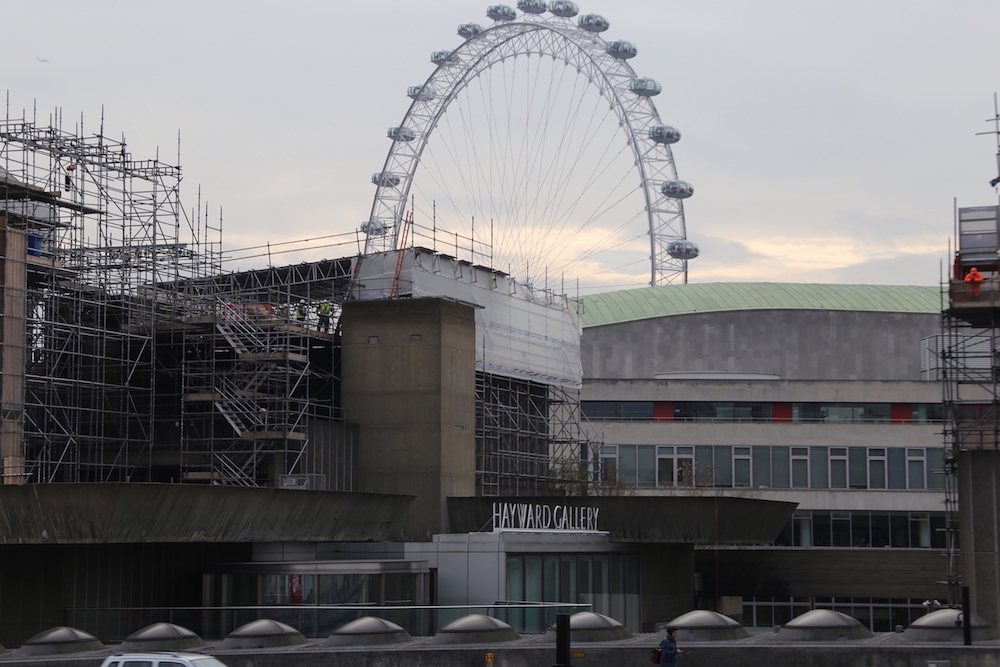Highlighting a fundamental change in the public’s view of the cultural hub, MA Culture, Criticism and Curation students have been investigating the concept of ‘heritage’ by looking at perceptions of the Southbank – in particular its 1960s buildings – through archival material as well as critical responses, experience, opinions, memories and movement in relation to the architectural environment.
With the exhibition now in its final days, we caught up with the students who have been curating the exhibition to find out more about its background.
What was your aim for the exhibition?
There were a number of aims, but our main focus was to look at the perceptions of Hayward Gallery and notions around Brutalist architecture. We wanted to interweave this with contemporary responses. Its point of departure is the current refurbishment of the Hayward Gallery which is scheduled to reopen in 2018 for the gallery’s 50th anniversary.
The focus of the exhibition is based on how the notion of heritage can be conceived differently – not only as something that is found in old images, newspaper articles and video recordings, and buildings, but also as something that can be experienced and actively expressed, for example, through dance.
How did you go about selecting the relevant archival material?
Using workshops as a tool for collaborative research was a central tenet of Heritage: A User’s Manual. By observing the Southbank Centre over the months leading up to the exhibition, we were able to understand the different types of people who inhabit the space on a daily basis as well as those who remember its history.
So the workshops were key to your interpretation of the archive…
We held two workshops with Southbank Centre users in the research stages of the exhibition. The first focused on the use of archival material as stimuli for the exchange of skills and transfer of knowledge. This resulted in some surprising outcomes. Two participants engaged in a sort of architectural dance-off, each constructing a bodily interpretation of Southbank Centre in response to the other. Other participants produced some striking drawings depicting archival material from an affective or anecdotal perspective.
While this early workshop and its outcomes do not feature in the exhibition it was an important conceptual turning point for the direction of the project. The second workshop was a more focused iteration of the first. Working with older and younger Southbank users belonging to South London Cares (a charity that organises intergenerational social events across South London), we used the archive to bring forth a variety of perspectives on Hayward Gallery. The result is a collection of oral histories that illuminate the ‘endotic’ aspects of Hayward Gallery’s heritage, a mode of thinking that we developed in order to encapsulate the un-exotic ‘everydayness’ that is so important to Southbank’s life from a user’s perspective.
An aspect of the exhibition uses dance as a response to the architecture of the building… What influenced you to take this approach?
The truism ‘writing about music is like dancing about architecture’ implies that both of these activities are extremely difficult, if not impossible. This challenge led to the question of how it is possible to dance about architecture, and it shaped the extensive research for the exhibition.
How have people responded to your presentation of the archive?
We have had many different responses to our exhibition. From the outset we had decided to collaborate with different user groups, but also with past and present people who have used Hayward Gallery. One aspect of this was shown through interviews with previous artists who exhibited there. Hayward Gallery’s exhibition programme in its early years is often associated with major retrospectives of well-established artists such as Matisse or van Gogh. The display of modern masterpieces no doubt had a beneficial impact, allowing the gallery to get a foothold in the international art scene. However, the least noted and archived exhibitions in the gallery’s programme perhaps carry greater relevance today.
How has the project helped to develop your curatorial approach?
Knowledge and understanding includes the development of a more complex view of self, and the experience on this project will definitely carry us through to the next exhibition, and every project that we work on in the future.
All in all, we, as a team, curated an exhibition, that we are proud of, and we all will carry this experience into the next stage of our careers. Our team curated an ambitious and multi-faceted exhibition. Not only did we exhibit archival material with several focuses; we also used the material to conceptualise and commission an installation; produce a series of videos and dance performances; research and interview previous exhibiting artists; and publish a content-driven publication.
More:




